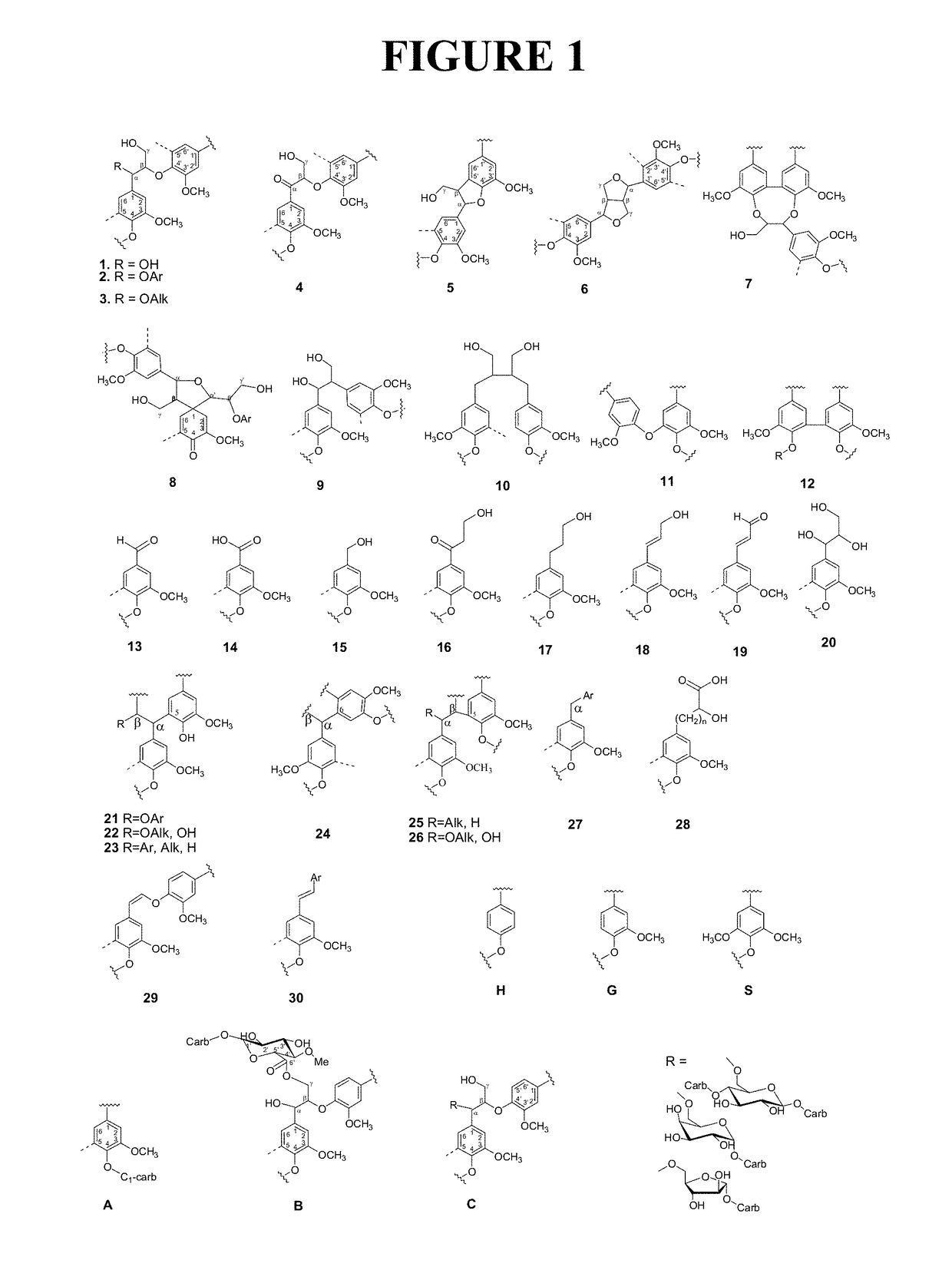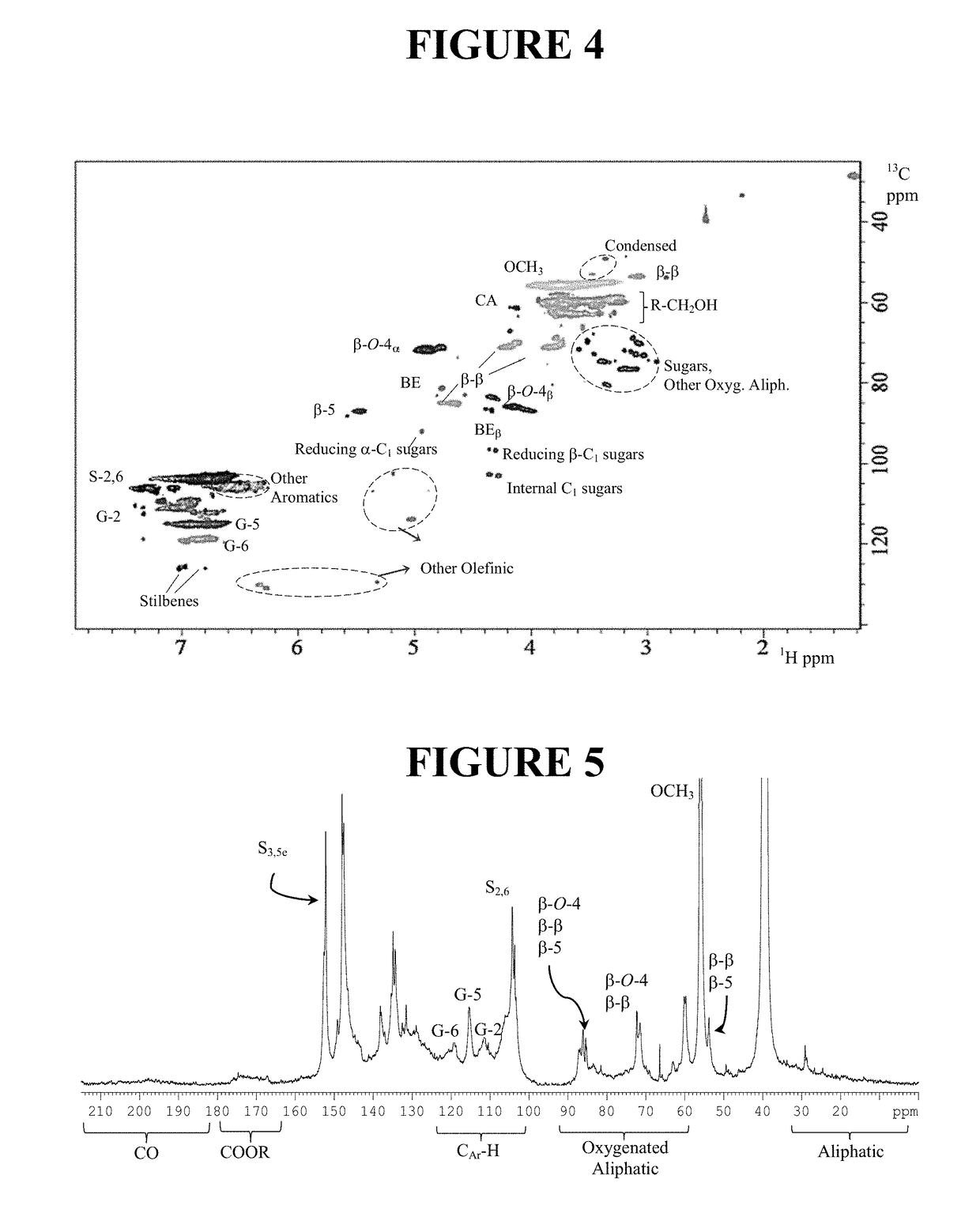High purity lignin, lignin compositions, and higher structured lignin
a technology of lignin and composition, which is applied in the field of high purity lignin and composition, can solve the problems of increasing the molecular mass of lignin, reducing the reactivity of lignin, and scientists attempting to question whether the structure truly is tridimensional
- Summary
- Abstract
- Description
- Claims
- Application Information
AI Technical Summary
Benefits of technology
Problems solved by technology
Method used
Image
Examples
example 1
[0110]This example demonstrates techniques used to extract lignins of the invention.
[0111]Biomass comprising hardwood was mixed with water to form a slurry. The slurry was reacted at a temperature of about 170-245° C. and a pressure of about 35-62 bar for a period of about 1-120 minutes. The reaction mixture was cooled to less than 100° C. and depressurized to less than 10 bar. The cooled and depressurized reaction mixture was then filtered using a filter press. The solids were collected and re-slurried with water. A portion of the slurry was then further processed according to one set of conditions (“Run 1”), and another portion of the slurry was then further processed according to a different set of conditions (“Run 2”).
[0112]In Run 1, the slurry was pumped at a rate of about 230 kg / h to about 270 kg / h at ambient conditions, while sub-critical, near-critical, or supercritical water having a temperature of about 360° C. to about 600° C. and a pressure of about 200 bar to about 600 ...
example 2
[0131]This example demonstrates nuclear magnetic resonance spectroscopy of lignins of the invention. This example also compares the lignins of the invention with conventional lignins.
[0132]The dioxane extracted lignin prepared in Example 1 was analyzed with 2D 1H—13C HSQC NMR (FIG. 4), and NaOH extracted lignin from Run 2 in Example 1 was measured with quantitative 13C NMR techniques (FIG. 5). Two dimensional NMR (e.g., HSQC) is a very powerful tool to identify various lignin moieties in a complex lignin sample as it provides good signal dispersion and allows more reliable assignments of the detected signals than other NMR techniques. However, a routine HSQC method is not typically quantitative, and therefore was complimented by a quantitative 13C NMR analysis for comprehensive lignin characterization.
[0133]The HSQC spectrum of the dioxane and NaOH extracted lignin showed the presence of significant amounts of native lignin subunits (FIGS. 4 and 5). In accordance with sugar analysis...
example 3
[0140]This example demonstrates lignin extraction yields using various extraction solvents. The extraction procedure is similar to that as described in Example 1.
[0141]The wet solids from Run 2 in Example 1, without any drying or grinding, were washed with water (“Run 2 wet”) and then extracted with the solvents shown in FIG. 6, namely, 40% ethanol in water, 50% ethanol in water, 60% ethanol in water, 99% methanol in water, 90% acetone in water, and 1 wt. % sodium hydroxide in water (all are % by volume unless otherwise indicated).
[0142]The dry and size-reduced unwashed solids of Run 2 (“Run 2 dry”) were extracted with the solvents shown in FIG. 6, namely, 70% ethanol in water, 90% acetone in water, 1 wt. % sodium hydroxide in water, and 90% dioxane in water (all are % by volume unless otherwise indicated).
[0143]The yields of the different solvent extractions are reported in FIG. 6.
PUM
| Property | Measurement | Unit |
|---|---|---|
| temperature | aaaaa | aaaaa |
| critical pressure | aaaaa | aaaaa |
| critical temperature | aaaaa | aaaaa |
Abstract
Description
Claims
Application Information
 Login to View More
Login to View More - R&D
- Intellectual Property
- Life Sciences
- Materials
- Tech Scout
- Unparalleled Data Quality
- Higher Quality Content
- 60% Fewer Hallucinations
Browse by: Latest US Patents, China's latest patents, Technical Efficacy Thesaurus, Application Domain, Technology Topic, Popular Technical Reports.
© 2025 PatSnap. All rights reserved.Legal|Privacy policy|Modern Slavery Act Transparency Statement|Sitemap|About US| Contact US: help@patsnap.com



